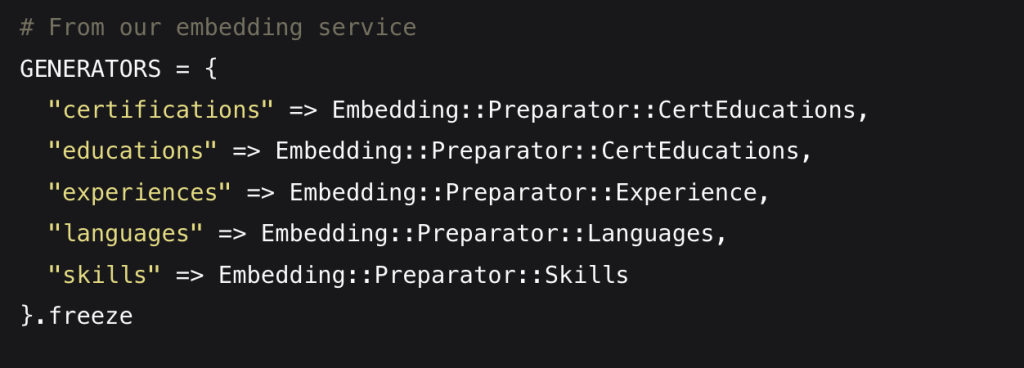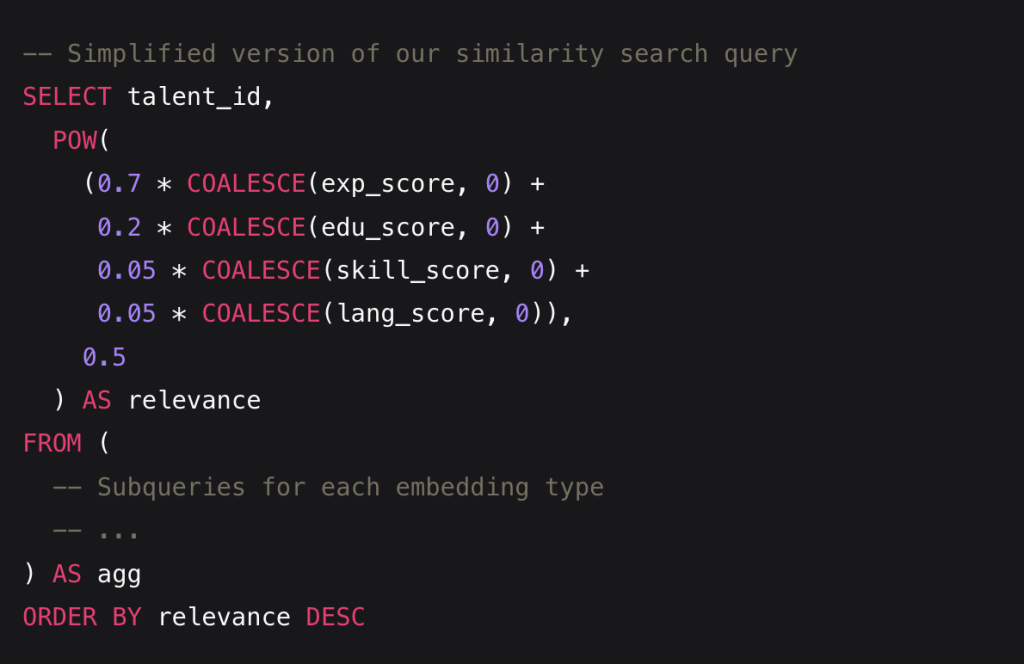
In traditional recruitment systems, finding candidates often relies on keyword matching – searching for exact terms like “Python” or “Project Manager” in resumes. This approach has significant limitations:
We needed a system that could understand the semantic meaning behind job requirements and candidate qualifications, not just match keywords.
Our approach leverages AI-powered vector embeddings to create a semantic search system that understands the meaning behind words, not just the words themselves. Here’s how it works:
Vector embeddings are numerical representations of text in a high-dimensional space where semantic similarity is captured by vector proximity. In simpler terms:
For example, in this space, “software engineer” and “developer” would be close together, while both would be further from “marketing specialist.”
A key insight in our implementation is that a single embedding for an entire resume is insufficient. Different aspects of a candidate’s profile need different types of semantic understanding:
Each of these aspects is embedded separately, allowing for more nuanced matching. For example:

This multi-embedding approach allows us to:
When a resume is uploaded to our system, it goes through a sophisticated processing pipeline:
The embedding generation process uses carefully crafted prompts to ensure consistent, high-quality embeddings:
## Instructions
You are provided with details for one candidate experience record, which includes the following:
– If any content is not in English, always translate into English.
– Ignore any duration or date information.
– Introduction should always start with “The candidate”
– Generate a standardized, descriptive text that summarizes this work experience.
– Always explain the candidate’s position in a clear and concise manner if you cannot do nothing.
– Your output should be one or two sentences that clearly explain the candidate’s role and responsibilities in a narrative format.
… more directives …
Notice how we explicitly ignore duration information in our prompts? This is intentional – we found that including years of experience in embeddings actually reduced matching quality by overemphasizing tenure rather than relevance of experience.
When a user searches for candidates, a similar process occurs:
Our query processing uses a specialized prompt that ensures consistent interpretation:
You are an AI system that processes talent queries and extracts key details into a JSON-formatted string.
Your output must include exactly four keys: `”experience”`, `”language”`, `”education”`, and `”skills”`. Follow these instructions:
1. **Output Format:**
IMPORTANT: The final output format must be in English only, even when the initial input is not in English.
The final output must be a single JSON string (without extra formatting) as shown below:
”'{ “title”: , “experience”: , “language”: , “education”: , “skills”: }”’
… more directives below …
Storing and querying vector embeddings efficiently is crucial for system performance. We leverage PostgreSQL with vector extensions (specifically pgvector) to handle this specialized data type.
To make similarity searches fast, we use specialized HNSW (Hierarchical Navigable Small World) indexes:
We specifically chose HNSW over other index types like IVF-Flat because it offers significantly better performance for our use case. HNSW builds a multi-layered graph structure that enables efficient approximate nearest neighbor search, dramatically reducing query times.
Additionally, we use the dot product (vector_ip_ops) as our similarity operator rather than cosine similarity. While cosine similarity is often the default choice for text embeddings, we found that using the dot product provides better performance without sacrificing accuracy in our normalized embedding space.
These optimizations dramatically speed up nearest-neighbor searches in high-dimensional spaces, making it possible to find the most similar candidates in milliseconds rather than seconds.
Our query structure is carefully optimized to balance accuracy and performance:

Notice the weighting factors: we give 70% weight to experience, 20% to education, and 5% each to skills and languages. These weights were determined through extensive testing and reflect the relative importance of each factor in predicting candidate success.
Problem: Our early version used a single embedding per talent, which created misleading similarity measurements. For example, two candidates with the same years of experience in completely different fields would appear more similar than they should.
Solution: We moved to multiple embeddings per talent (experience, education, skills, languages), each focused on a specific aspect. This approach recognizes that the embedding space isn’t perfectly calibrated for talent search – it’s a general semantic space where “distances” don’t always reflect business-relevant distinctions. By separating different aspects and weighting them appropriately, we can better control how similarity is calculated.
For example, with separate embeddings, a software developer with 5 years of experience and a marketing specialist with 5 years of experience would no longer appear artificially similar just because they share the same tenure. Instead, their experience embeddings would correctly place them in different regions of the semantic space.
A typical implementation might use an event-driven approach:
Problem: Early versions produced inconsistent embeddings, especially for similar experiences described differently.
Solution: We developed standardized prompts that normalize the text before embedding, focusing on roles and responsibilities while ignoring potentially misleading details like years of experience.
Problem: As our database grew, query performance degraded.
Solution: We implemented:
Problem: Our talent pool includes resumes in multiple languages, but we use an English-only embedding model for optimal performance.
Solution: Rather than using less accurate multilingual embedding models, we translate all content to English during the normalization process before embedding. This approach allows us to use a high-quality English-specific embedding model while still supporting our international talent pool. The translation step is integrated directly into our prompt templates:
## Instructions
You are provided with details for one candidate experience record, which includes the following:
– If any content is not in English, always translate into English.
…
This standardized translation ensures consistent semantic representation regardless of the original language, maintaining high-quality embeddings across our entire database.
Problem: Many talents in our database had non-descriptive or vague experience entries like “Data entry specialist” or “Outsourcer specialist” which polluted search results by creating misleading embeddings.
Solution: We implemented a comprehensive database cleanup process:
This data quality initiative significantly improved our matching results by ensuring that all embeddings were generated from meaningful, descriptive content.
Problem: Early versions either returned too many irrelevant candidates or missed qualified ones.
Solution: We fine-tuned our similarity thresholds and implemented a weighted scoring system that combines multiple embedding types, achieving approximately 95% confidence in our top results.
The implementation of our vector embedding-based talent matching system has transformed our recruitment process:
Our journey building a semantic talent matching system demonstrates the power of vector embeddings for understanding the nuanced relationships between job requirements and candidate qualifications. By embedding different aspects of resumes separately, optimizing our database for vector operations, and carefully tuning our matching algorithms, we’ve created a system that consistently finds the right candidates with approximately 95% confidence.
The approach we’ve taken – using multiple embedding points, ignoring potentially misleading information like years of experience, and leveraging PostgreSQL’s vector capabilities – has proven highly effective for talent matching. These same principles could be applied to many other domains where semantic understanding is more important than keyword matching.
Have you implemented vector search in your applications? We’d love to hear about your experiences and challenges. Reach out to our team to share your thoughts or learn more about our implementation.
This article describes a feature of the Pulse platform, which is the system powering Ingedata’s business. Stay tuned for more insights into how we’re using cutting-edge technology to solve real business problems.





Proudly awarded as an official contributor to the reforestation project in Madagascar
(Bôndy - 2024)